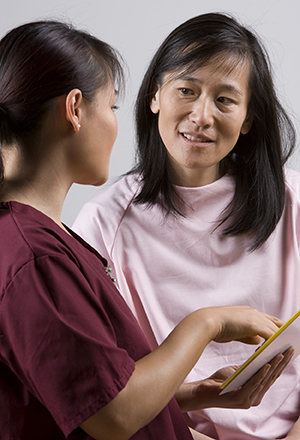Clinical Breast Exam
Many health organizations recommend a yearly clinical breast exam. This exam may be done by a gynecologist, family healthcare provider, nurse practitioner, nurse midwife, or specially trained nurse. Yearly breast exams help to make sure that breast conditions are found early.
Your healthcare provider’s role
A healthcare professional knows the tests and follow-up care needed if a problem is found. Your clinical exam is also a great time to ask questions about breast self-exams. You can find out if you’re checking your breasts in the best way. Or you may want to ask how pregnancy, breast implants, or breast reduction surgery affect the way you should check your breasts.

Diagnostic tests
If a clinical exam reveals a breast change, you may have other tests to find out more. These tests may include:
-
Mammography. A low-dose X-ray of your breast tissue.
-
Ultrasound. An imaging test that uses sound waves to create images of your breast.
-
Biopsy. A small amount of breast tissue is removed by needle or by a cut (incision). The tissue is then checked under a microscope.
Guidelines for having clinical breast exams
The American College of Obstetricians and Gynecologists (ACOG) recommends that starting at age 29, you should have a clinical breast exam every 1 to 3 years. After age 40, have a clinical breast exam each year. If you’re at higher risk for breast cancer, you may need exams more often. Risk factors for breast cancer may include:
-
Being over 50 or postmenopausal
-
Having a family history of breast cancer
-
Having the BRCA1 or BRCA2 gene mutation or certain other gene mutations
-
Having more menstrual periods due to starting menstruation early (before age 12) or having a late menopause (after age 55)
-
Having no pregnancies
-
Having a first pregnancy after age 30
-
Being obese
-
Having a history of radiation treatment to your chest area
-
Exposure to DES during your mother's pregnancy
-
Not being active
-
Drinking too much alcohol
-
Having dense breast tissue
-
Taking hormone therapy after menopause
Other health organizations have different recommendations. Talk with your healthcare provider about what is best for you.
Online Medical Reviewer:
Donna Freeborn PhD CNM FNP
Online Medical Reviewer:
Heather M Trevino BSN RNC
Online Medical Reviewer:
Irina Burd MD PhD
Date Last Reviewed:
11/1/2022
© 2000-2025 The StayWell Company, LLC. All rights reserved. This information is not intended as a substitute for professional medical care. Always follow your healthcare professional's instructions.